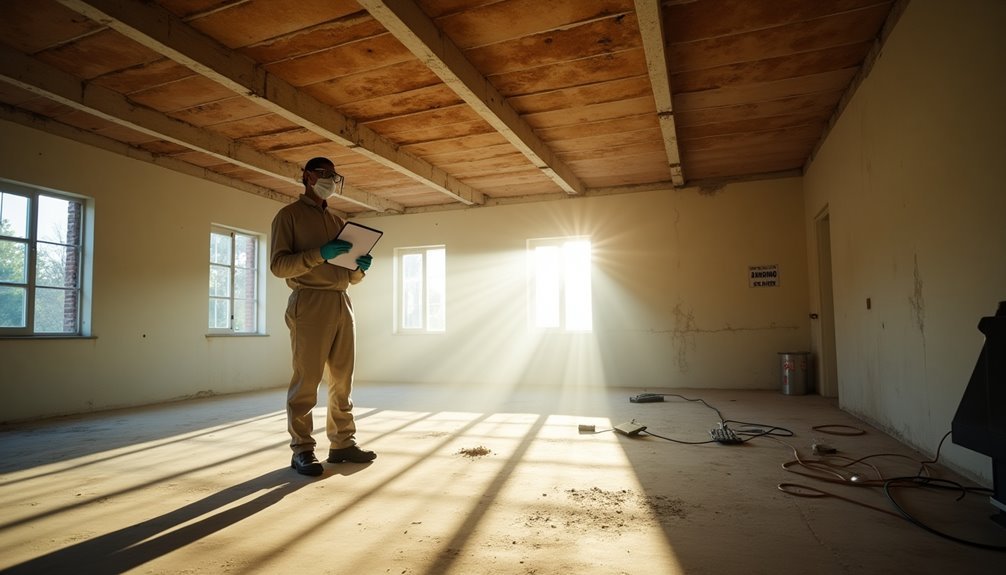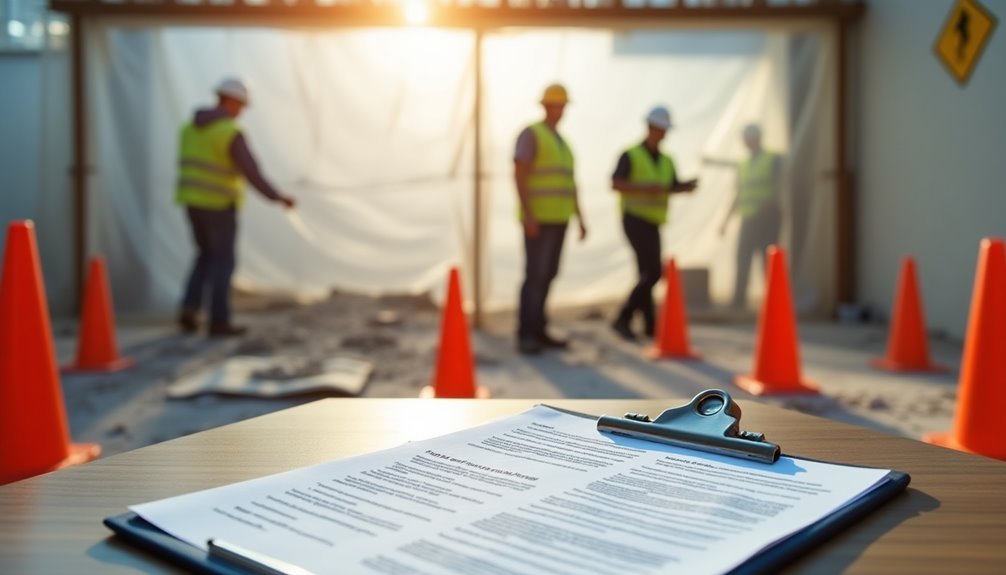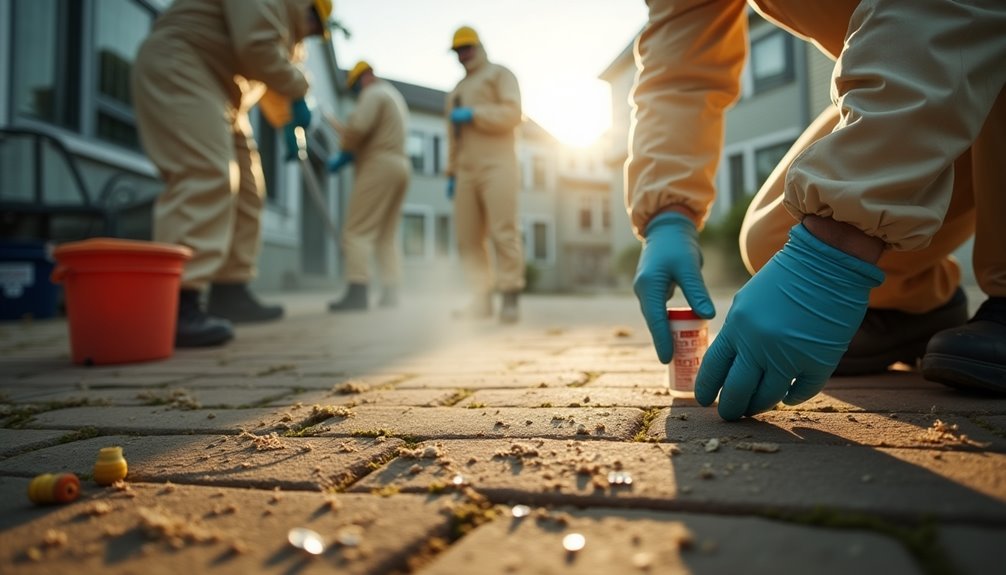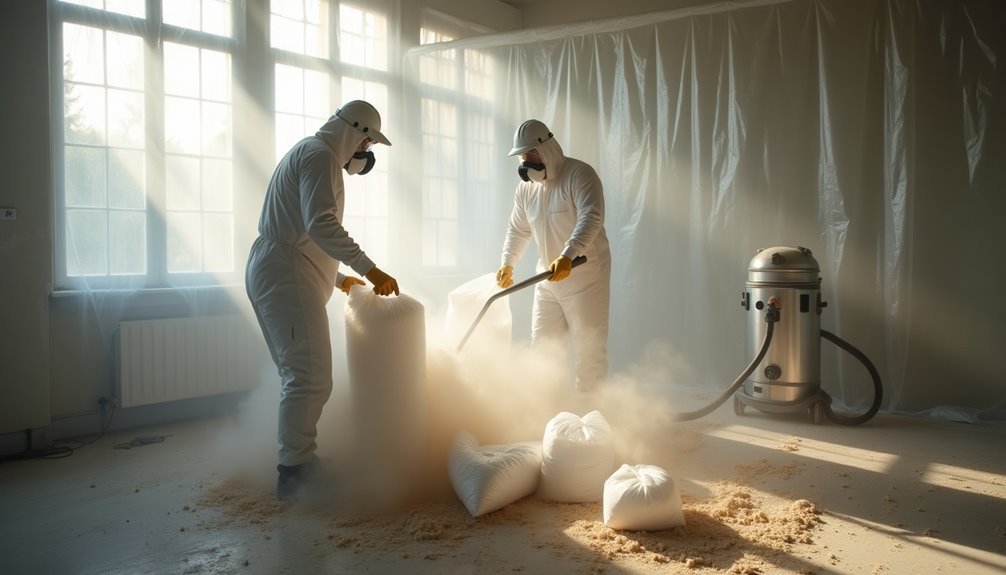The complete asbestos abatement process starts with an initial inspection, identifying any asbestos-containing materials (ACMs) in your home. After assessing the risks, you'll develop an abatement plan that complies with regulations, ensuring safety for all involved. You'll implement containment measures to isolate the work area, followed by safe removal of ACMs using wet methods to minimize fiber release. Cleaning involves thorough removal of residual fibers, with clearance testing to confirm safety. Finally, you'll dispose of asbestos waste in compliance with DOT and EPA regulations, ensuring your home is safe from asbestos hazards. You'll find further details essential for your project ahead.
Initial Inspection and Testing

The initial inspection and testing for asbestos involves a systematic approach to identify potential asbestos-containing materials within a property. You'll start with a historical review of the property, gathering information from property owners, occupants, or maintenance personnel about the materials used and any previous renovations. This step is crucial for effective asbestos identification.
Next, employ thorough inspection techniques, conducting a visual examination of accessible areas to spot signs of damage or degradation that could release asbestos fibers. Focus on common areas like insulation materials, roofing and siding shingles, floor tiles, and pipe insulation. Don't overlook textured paints, as they may also contain asbestos. Asbestos is a group of six naturally occurring fibrous minerals, and identifying these materials is essential for ensuring safety during the inspection process.
Carefully document all findings to support your risk assessment. If you suspect materials contain asbestos, collect samples for laboratory analysis. Submit these samples to accredited labs for testing, where stereomicroscopy and polarized light microscopy (PLM) will confirm the type of asbestos present. Ensure compliance with regulatory standards to maintain safety throughout the process.
Development of an Abatement Plan
When developing your abatement plan, you need to clearly outline the scope of work, detailing the areas affected and the amount of asbestos-containing materials involved. It's crucial to incorporate comprehensive safety measures to protect workers and occupants during the process. Additionally, ensure your plan meets all regulatory compliance requirements to avoid delays and legal issues. Effective asbestos management is essential to prevent any potential exposure during the abatement activities.
Scope of Work
Developing a comprehensive abatement plan is crucial for effectively managing asbestos removal. It begins with a clear scope definition, which outlines the areas and materials to be abated. You'll need to identify asbestos-containing building materials (ACBMs), classifying them as friable or non-friable, and documenting your findings meticulously. This documentation lays the groundwork for your project timeline.
Here's a simple breakdown of the scope of work components:
| Component | Description | Importance |
|---|---|---|
| Identification of Asbestos | Conduct inspections and sample locations | Ensures accurate assessment |
| Scope and Objectives | Define areas and abatement methods | Guides the overall process |
| Regulatory Compliance | Submit plan for approval | Ensures legal adherence |
| Documentation & Maps | Create updated blueprints | Visual reference for abatement |
| Communication | Notify relevant parties before work | Maintains transparency |
Following these steps ensures that you're minimizing exposure risks while adhering to local, state, and federal laws. Coordinate with the building owner for approval and compliance to keep your project on track.
Safety Measures
Ensuring worker safety during the asbestos abatement process is paramount to minimizing health risks. Start by conducting a comprehensive risk assessment to evaluate the condition of asbestos-containing materials (ACM) and determine the potential for disturbance. This assessment informs your decisions on encapsulation, enclosure, or removal. Identify high-traffic areas with damaged materials that may require complete removal, and ensure your team has specialized tools like negative air machines and HEPA vacuums.
Train your workers appropriately based on exposure risks, providing NIOSH-approved respirators and protective clothing. Establish strict procedures for donning and doffing personal protective equipment (PPE) to prevent contamination, and enforce hygiene protocols, such as washing exposed body parts after work.
Implement containment measures by sealing off the work area with plastic sheeting and using negative air pressure systems to minimize fiber release. Modify or shut down HVAC systems to avoid spreading asbestos fibers. Finally, ensure proper clean-up and disposal by wetting asbestos materials, using non-powered tools, and packaging waste in double-layered polythene bags labeled 'ASBESTOS WASTE'. Following these safety measures in line with asbestos regulations will protect your workers and ensure a safer environment.
Regulatory Compliance
Creating a comprehensive asbestos abatement plan is essential for compliance with regulatory standards and ensuring the safety of all involved. You must navigate a complex framework of asbestos regulations set by federal, state, and local governments. Here's what you need to include in your plan:
- Detailed scope of work
- Selected abatement methods
- Compliance training for workers
- Notification and permit requirements
Your plan must be submitted to the relevant state program for approval before any abatement work begins. Ensure that your plan includes all necessary details, including the condition of the asbestos-containing materials and potential exposure risks. Remember that if you're working on school buildings, additional requirements apply, often necessitating a certified Project Designer to oversee the plan.
Don't forget: you'll need to submit notifications at least 10 days prior to starting work, and larger projects may require specific permits. Also, keep in mind that once approved, you must commence work within six months to maintain your compliance status. Following these steps will help you achieve a safe and compliant asbestos abatement process.
Notification and Permitting

Before starting any asbestos abatement work, you must notify the relevant regulatory agencies at least 10 working days in advance. This process includes submitting a permit application if your project involves 160 square feet or more of asbestos-containing material. Ensuring accurate and timely notifications and permits is crucial for compliance and the smooth execution of your abatement project.
Regulatory Agency Notifications
The asbestos abatement process mandates specific regulatory agency notifications for all demolition and renovation projects, regardless of asbestos presence. Understanding these requirements is crucial for compliance and safety.
- Submit notification forms at least 10 working days prior to project start.
- Check state and local regulations for specific timelines.
- Ensure notifications detail the project scope and asbestos information.
- Be aware of potential exemptions for small residential structures.
You'll need to submit the notification forms to relevant regulatory agencies, such as the U.S. EPA or your state's environmental protection department. These forms must be completed by a certified asbestos inspector or your project's agent and should include essential details like start and end dates, location, and the presence of asbestos-containing materials (ACM).
Permit Acquisition Process
How do you navigate the permit acquisition process for asbestos abatement projects? First, you'll need to determine the appropriate permit types based on your project specifics. Submit the required asbestos project notification forms, such as the ACP-7 in New York City, along with pertinent construction documents. Utilize electronic submission platforms like the Asbestos ePermitting System in Washington D.C. or ARTS in New York. Remember, you must submit notifications at least 10 working days before starting the project, barring emergencies.
Prepare a Workplace Safety Plan (WPSP) by a registered design professional that outlines the scope of work and safety measures. After submission, expect a technical review from agencies like the DEP's Asbestos Technical Review Unit. Approval of the WPSP is necessary before receiving your asbestos abatement permit.
Once approved, you'll receive a site-specific permit, which must be posted at the work site along with the WPSP. Be mindful of the application timeline and ensure you comply with all regulations to avoid fines. Finally, keep detailed records of inspections and compliance checks for at least six years to uphold your project's integrity.
Containment and Air Filtration
Effective containment and air filtration are crucial components of the asbestos abatement process, ensuring that harmful fibers don't escape into surrounding areas. You need to utilize robust containment techniques to safeguard both workers and occupants, isolating the work area with plastic sheeting and employing negative air pressure machines. This prevents fiber dispersal and maintains air quality throughout the abatement.
- Use of HEPA-certified air purifiers to capture asbestos fibers
- Air quality testing to confirm safe levels before dismantling containment
- Specialized tools with local ventilation to minimize fiber release
- Disposable protective clothing for workers to prevent cross-contamination
HEPA filters are essential, as they remove 99.97% of air pollutants down to 0.01 microns. Alongside portable HEPA vacuum cleaners, these systems ensure that residual asbestos fibers are effectively eliminated from the work area. Regular air quality testing is critical, allowing you to verify that asbestos levels remain below safe limits. By implementing thorough containment and air filtration measures, you create a safer environment, allowing for successful asbestos abatement while prioritizing health and safety.
Safe Asbestos Removal

Safe asbestos removal is a meticulous process that requires careful planning and execution to protect both workers and the environment. First, you need to conduct a thorough assessment to identify and quantify asbestos-containing materials (ACMs). Hiring a licensed asbestos inspector is crucial for confirming the presence and concentration of asbestos fibers. Assess the condition of these materials—whether they're intact or damaged—since this will influence your approach.
Before removal, turn off HVAC systems and seal vents to prevent the spread of asbestos fibers. Use wetting agents to saturate ACMs, minimizing fiber release during removal. Prepare the area by erecting barriers and implementing negative air pressure systems with HEPA filters.
When employing removal techniques, utilize wet methods and controlled dismantling to ensure minimal disturbance. Handle ACMs gently and double-bag them securely for safe disposal. Throughout this process, prioritize worker safety by providing appropriate personal protective equipment (PPE) and establishing cleaning stations.
Cleaning and Clearance
Cleaning and clearance are critical steps in the asbestos abatement process, ensuring that the work area is free from hazardous materials before reoccupation. To achieve this, you must adhere to specific cleaning techniques and clearance protocols designed to protect your health and safety.
- Seal the work area to prevent air circulation.
- Use wet cleaning methods to control dust and debris.
- Employ HEPA filters and vacuums for effective cleanup.
- Conduct thorough clearance testing to verify safety.
Start by sealing off sections not involved in the abatement, ensuring no contaminated air escapes. Utilize wet cleaning methods, such as damp mops and rags, to minimize fiber release. Avoid dry sweeping, which can stir up harmful particles. After cleaning, vacuum with HEPA-filtered equipment to capture residual asbestos fibers, ensuring attachments are easy to decontaminate.
Finally, implement clearance testing to confirm that air and material levels meet OSHA regulations. An independent inspection will validate the effectiveness of your cleaning efforts. By following these steps diligently, you'll create a safe environment for reoccupation, liberating your home from the dangers of asbestos.
Disposal of Asbestos Waste

Once you've completed the cleaning and clearance of the work area, the next step involves the proper disposal of asbestos waste, which is paramount to maintaining safety and compliance. First, identify all asbestos-containing materials (ACMs) and wet them to minimize fiber release. Seal these materials in two layers of 6-millimeter plastic bags or 0.2 mm thick polythene sheeting, ensuring they're clearly labeled with warning signs.
When packaging, use airtight containers with lids and label each bag with your name and address. Adhere strictly to DOT and EPA regulations for transportation, utilizing non-perforated tarps or enclosed containers. Display required warning signs and DOT placarding on the transport unit.
For disposal, use a landfill authorized by the EPA. Notify the landfill and relevant authorities 24 hours in advance, and maintain records of the waste shipment for at least two years. Ensure the transporter complies with OSHA, DOT, and NESHAPS regulations. Finally, cover inactive disposal sites with non-ACM materials and maintain vegetation to prevent exposure. Following these asbestos regulations ensures effective waste management and protects public health.
Conclusion
In conclusion, ensuring your home's safety from asbestos hazards is crucial. Did you know that approximately 1.3 million workers are exposed to asbestos in the U.S. each year? By following a meticulous asbestos abatement process—from initial inspection to safe disposal—you significantly reduce health risks for yourself and your loved ones. Always prioritize professional help and adhere to regulations. Your home deserves to be a safe haven, free from harmful materials that can lead to serious health issues.
